This article was written exclusively for Investing.com
- Monday, July 19, was an ugly day in the oil path
- The elevator stopped at a higher floor
- Crude oil did not stay down for long
- The counter-intuitive move as the US follows a greener energy path
- Crude oil is heading for triple digits, and gasoline looks set to challenge $3 per gallon
It is hard to believe that fifteen short months ago, the price of nearby NYMEX crude oil futures traded to a record low at negative $40.32 per barrel. An almost perfect bearish storm hit the oil market on Apr. 20, 2020. Discord among OPEC members caused no initial response to the global pandemic that caused energy demand to evaporate. US production rose to a new record high at 13.1 million barrels per day in March 2020. With the price dropping like a stone, contango or the premium for deferred delivery rose to the widest levels in years, if not history. Oil merchants scrambled to buy nearby crude oil and store the energy commodity, selling forwards for futures for deferred delivery. Storage facilities filled until there was nowhere to put the energy commodity. As the nearby futures contract on landlocked WTI NYMEX crude oil futures rolled around in late April, those holding long positions had nowhere to store the petroleum and faced deliveries in Cushing, Oklahoma. Without any storage, buyers who purchased oil at contract lows, zero, and even at negative prices were forced to sell at any prices, pushing the price to the low at over the negative $40 level.
Since then, the crude oil futures market has made higher lows and higher highs. The most recent peak came on July 6, when the energy commodity briefly rose above the October 2018 high and technical resistance level at $76.90 per barrel. Nearby futures hit $76.98, $117.30 above the Apr. 20, 2020 low. Crude oil did not move higher over fifteen months in a straight line. A correction from the new marginal multi-year high was overdue. Crude oil began to experience selling as OPEC+ could not agree on production policy at its biannual meeting. A compromise and news that COVID-19 Delta variant cases were rising set the stage for the first significant price decline in months.
Monday, July 19, was an ugly day in the oil path
Before July, nearby NYMEX crude oil futures suffered the most substantial decline of 2021 in March, when the price dropped from $67.98 to $57.25 per barrel. After reaching the high on Mar. 8, the price found a bottom on Mar. 23. The most significant drop came on Mar. 18, when September futures fell $4.35 per barrel.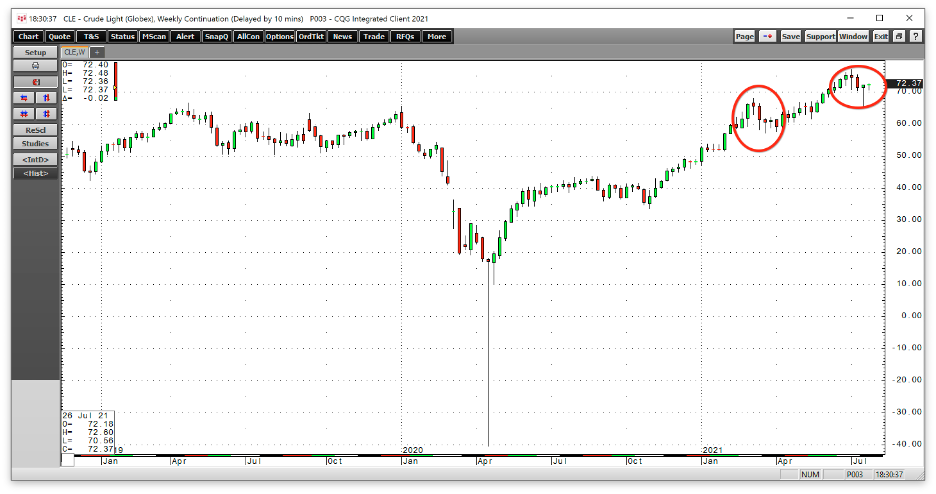
Source: CQG
After the March correction until July 6, crude oil futures made higher highs when the price rose to its highest level since 2014 and turned lower. OPEC+’s compromise on tapering production cuts and increasing number of Delta variant COVID-19 cases caused selling to return to the petroleum futures market. After reaching a high of $76.98 on July 6, the price dropped to a low of $65.21 on July 20. On July 19, the September futures contract fell $4.64, edging out Mar. 18 for the ugliest day in the oil futures market in 2021.
The elevator stopped at a higher floor
Crude oil takes the stairs higher and an elevator to the downside during corrections. The energy commodity has been climbing a steep flight of bullish stairs since April 2020, with only a few pullbacks. However, memories of the decline that took the price below zero remain fresh in the minds of market participants, making price corrections more than scary. The selling in March led to a higher low and higher highs over the following weeks. In early June, after crude oil had digested the correction, the price made a higher high.
The most recent selling took the nearby NYMEX and Brent futures to another in a long series of higher lows. Crude oil’s elevator ride to the downside stopped at a higher floor. Elevator rides lower have been short-lived in the crude oil futures arena.
Crude oil did not stay down for long
In March, it took only two trading sessions after the most significant drop to reach a bottom. In July, the energy commodity found the bottom the next day.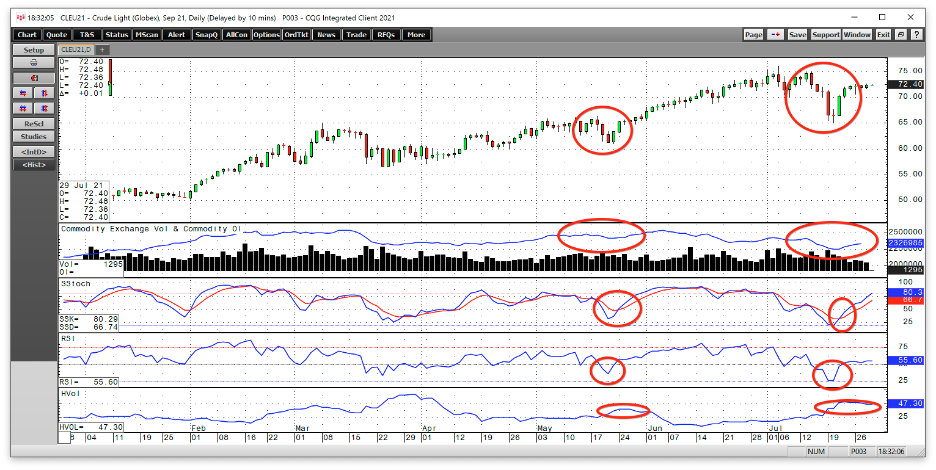
Source: CQG
The chart shows that the March and July corrections caused open interest, the total number of open long and short positions in the crude oil futures market to drop. Falling price and declining open interest is not typically a technical validation of a bearish trend in a futures market. Moreover, the price action turned out to be healthy as it cleaned out the weaker longs.
The corrections pushed price momentum and relative strength lower. In both cases, the indicators rose with the price over in the aftermath of the selling. Since the energy commodity loves to take the elevator lower, daily historical volatility expands during selloffs. The metric rose to a high of 39.25% in March and 52.21% in July. If the price of crude oil repeats its trading pattern and begins to climb towards another higher high, the pride variance metric will likely decline over the coming days and weeks.
Corrections may be frightening, but they have been cleansing for the oil market as the bullish trend continues in the energy patch.
The counter-intuitive move as the US follows a greener energy path
One of the leading reasons for crude oil’s ascent has been the dramatic shift in US energy policy under the Biden administration. In January, the President signed an executive order canceling the Keystone XL pipeline, a critical petroleum infrastructure project that carries oil from Canada to Nebraska and beyond to the NYMEX delivery point in Cushing, Oklahoma.
In May, the administration banned drilling and fracking on federal lands in Alaska. The greener path for US energy comes as demand has returned with a vengeance. As vaccines create immunity to the worst consequences of COVID-19 and variants, people are returning to work and traveling, increasing energy demand. Crude oil and oil products continue to dominate energy requirements as most cars, trucks, planes, and other transportation infrastructures run on hydrocarbons. Decarbonization is a multi-year, if not multi-decade initiative. While rising energy prices may be counter-intuitive when addressing climate change, the rising demand has handed the pricing power in the petroleum market back to OPEC and Russia. The oil cartel’s mission is to deliver the highest possible price for its members.
Meanwhile, crude oil is not the only traditional energy commodity on a bullish path. Other fossil fuels have moved to multi-year peaks.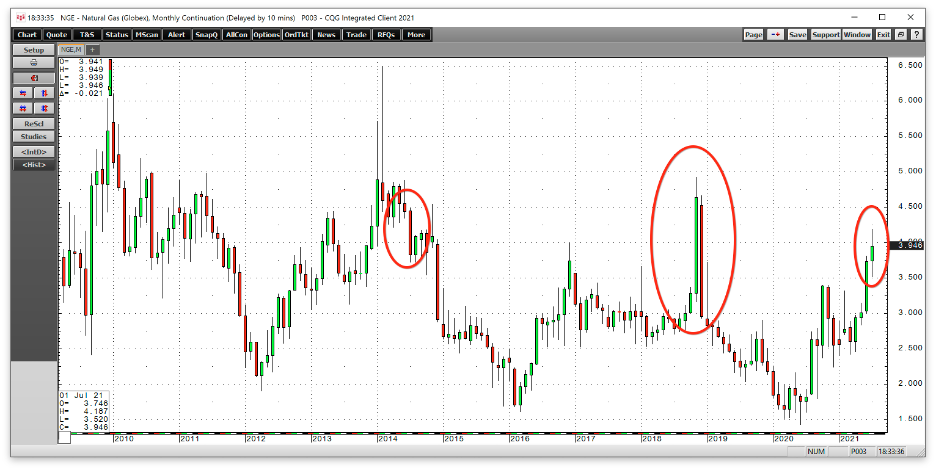
Source: CQG
The monthly chart shows natural gas futures traded to a high of $4.187 per MMBtu this week, the highest price since December 2018. However, the last time the price eclipsed the $4 level in July was in 2014. Seven years ago, natural gas was trending lower at over $4. In 2021, the trend remains higher.
Coal has been a four-letter word in energy as the fossil fuel has been the target of environmentalists for years. However, China and India, the world’s most populous nations with over one-third of the global population, continue to experience rising demand for coal. Addressing climate change has caused coal production to decline, but the demand has pushed prices to multi-year highs. 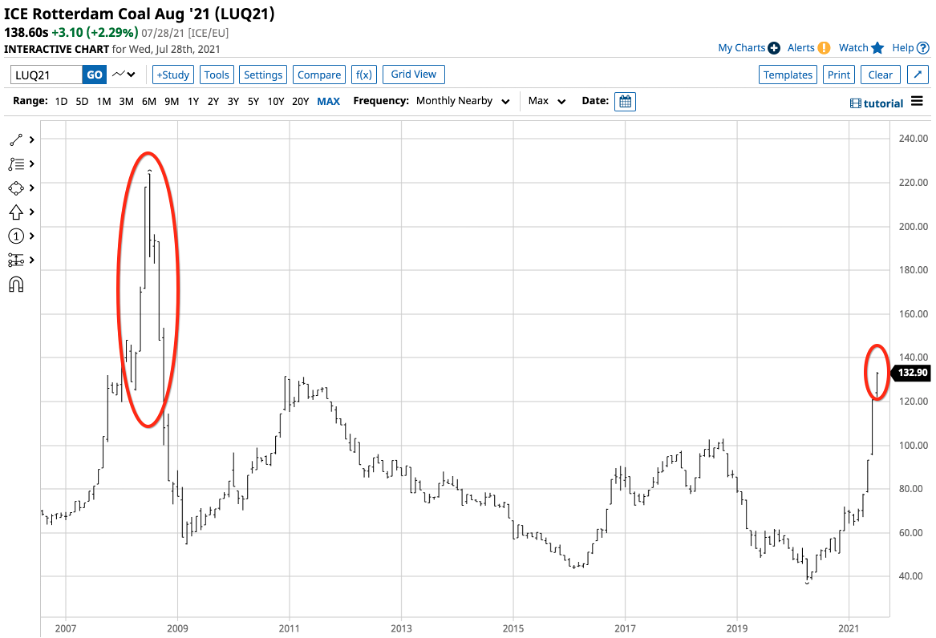
Source: Barchart
The chart shows thermal coal for delivery in Rotterdam, the Netherlands, closed at $138.60 per ton on July 28. Coal has not traded at the current price level since 2008.
Fossil fuel prices are all in bullish technical trends at the end of July 2021.
Crude oil is heading for triple digits, and gasoline looks set to challenge $3 per gallon
While technical factors continue to point higher, fundamentals in the oil and gas markets agree. In crude oil, US daily output at 11.2 million barrels as of the week ending on July 23 is 14.5% below the record high from March 2020. The shift in US energy policy is limiting production.
In 2021, crude oil, gasoline, and distillate inventories have declined. According to the Energy Information Administration, from Jan. 1, 2021, through July 23, crude oil stockpiles declined by 57.8 million barrels, gasoline stocks fell by 2.4 million, and distillate inventories moved 13.8 million barrels lower. The fundamentals support higher crude oil prices.
In natural gas, inventories in storage in the US are at low levels as the market prepares for the peak 2021/2022 winter season.
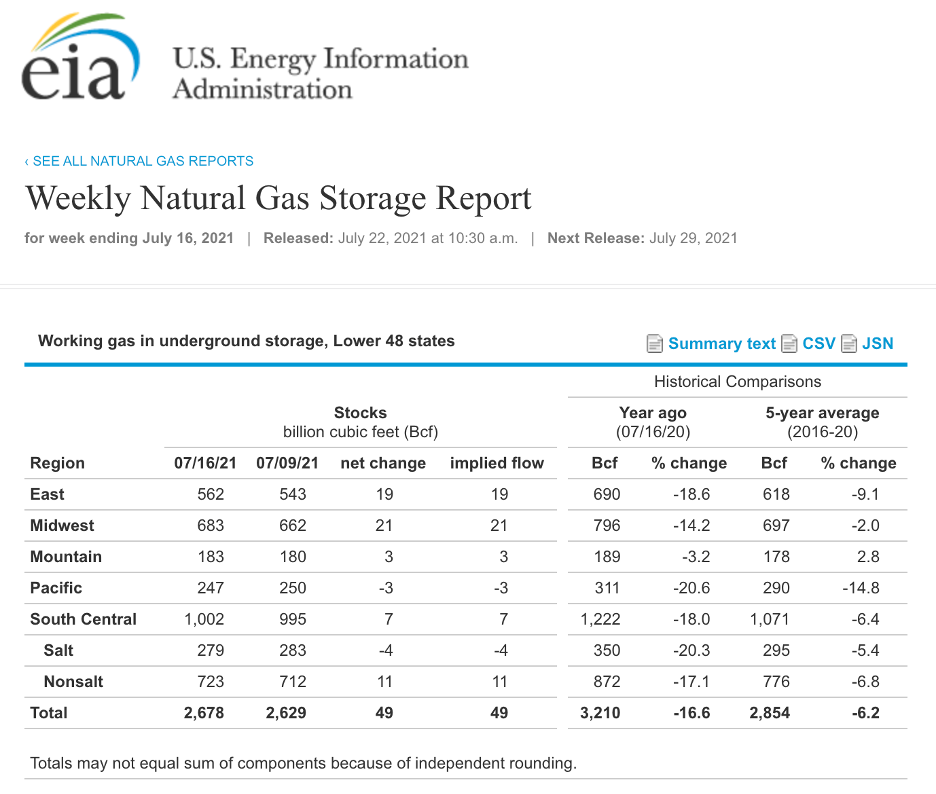
Source: EIA
As the chart illustrates, natural gas in storage was 16.6% below last year and 6.2% under the five-year average as of July 16.
Before the most recent correction, nearby NYMEX crude oil futures rose to a high of $76.98 per barrel. 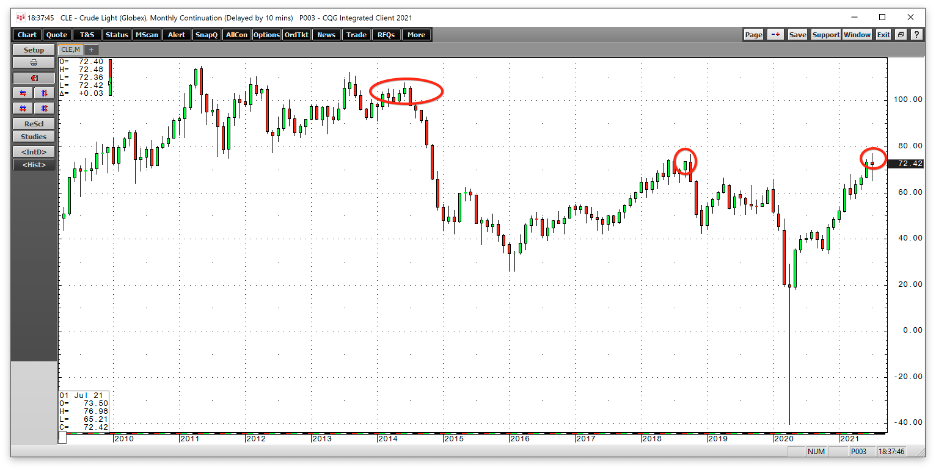
Source: CQG
As the monthly chart highlights, crude oil moved marginally above the October 2018 $76.90 high. The next technical target stands at the June 2014 $107.73 high. 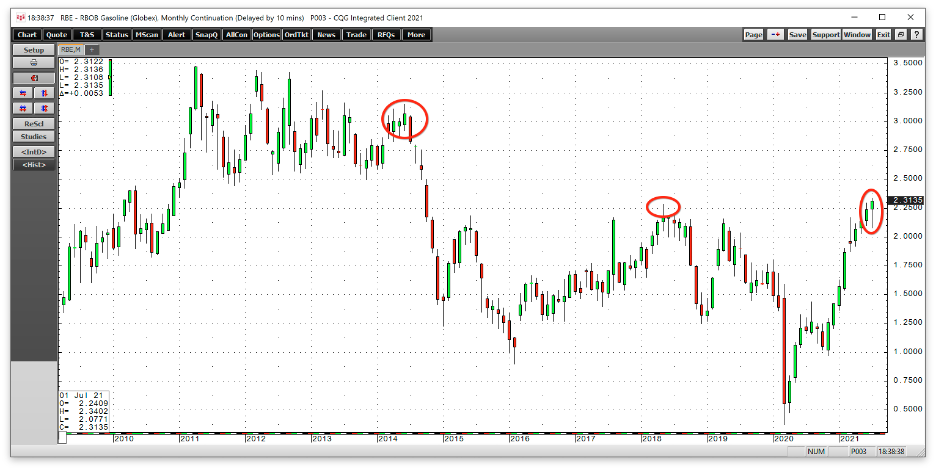
Source: CQG
The gasoline futures market moved to a high of $2.3402, surpassing the May 2018 $2.2855 peak. The next upside target is at $3.1520, the June 2014 high. In natural gas, the technical target stands at the November 2018 $4.929 high. Above there, in February 2014, natural gas reached $6.493 per MMBtu.
Crude oil took another elevator ride lower on July 19, but it stopped at a higher floor. If the price action over the past fifteen months is a guide, we could be heading higher in the traditional energy commodities. The trend is always your best friend in markets. When fundamentals and technicals point in the same direction, they combine to be a powerful force. The risk of future corrections will rise with the prices, but the path of least resistance remains bullish.
